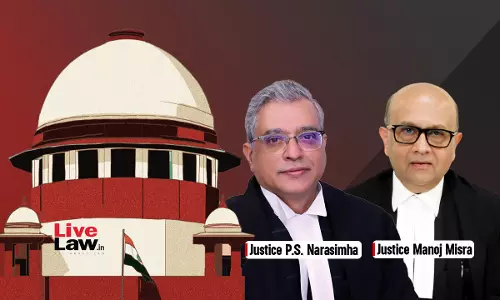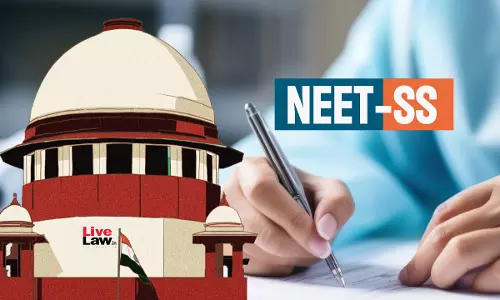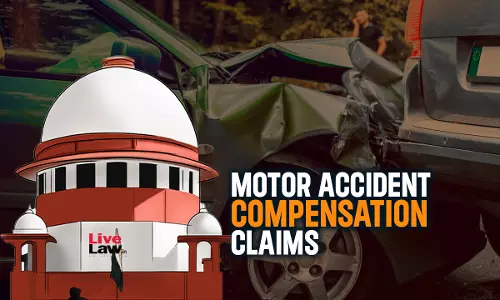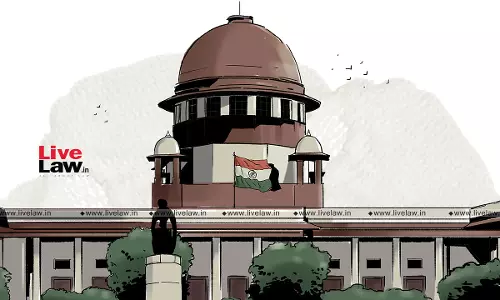Driver Holding LMV Licence Can Drive Transport Vehicle Of Such Class Without Any Endorsement: SC [Read Judgment]
![Driver Holding LMV Licence Can Drive Transport Vehicle Of Such Class Without Any Endorsement: SC [Read Judgment] Driver Holding LMV Licence Can Drive Transport Vehicle Of Such Class Without Any Endorsement: SC [Read Judgment]](https://www.livelaw.in/cms/wp-content/uploads/2018/03/supreme-court-of-india-2.jpg)
In an important judgment in the realm of Motor Vehicle Laws, the Supreme Court, in Mukund Dewangan vs. Oriental Insurance Company Limited, has held that there is no requirement to obtain separate endorsement to drive transport vehicle, and if a driver is holding licence to drive light motor vehicle, he can drive transport vehicle of such class without any endorsement to that effect.A...
In an important judgment in the realm of Motor Vehicle Laws, the Supreme Court, in Mukund Dewangan vs. Oriental Insurance Company Limited, has held that there is no requirement to obtain separate endorsement to drive transport vehicle, and if a driver is holding licence to drive light motor vehicle, he can drive transport vehicle of such class without any endorsement to that effect.
A bench comprising Justice Amitava Roy, Justice Arun Mishra and Justice Sanjay Kishan Kaul was answering reference made to it by a division bench, when it observed certain inconsistencies in some of the judgments. The questions referred by the division bench and the answers to it by the three-judge bench are the following:
What is the meaning to be given to the definition of "light motor vehicle" as defined in Section 2(21) of the MV Act? Whether transport vehicles are excluded from it?
‘Light motor vehicle’ as defined in section 2(21) of the Act would include a transport vehicle as per the weight prescribed in section 2(21) read with section 2(15) and 2(48). Such transport vehicles are not excluded from the definition of the light motor vehicle by virtue of Amendment Act No.54/1994.
Whether 'transport vehicle' and 'omnibus', the "gross vehicle weight" of either of which does not exceed 7,500 kg, would be a "light motor vehicle" and also motor car or tractor or a road roller, "unladen weight" of which does not exceed 7,500 kg and holder of a licence to drive the class of "light motor vehicle" as provided in Section 10(2)(d) would be competent to drive a transport vehicle or omnibus, the "gross vehicle weight" of which does not exceed 7,500 kg or a motor car or tractor or road roller, the "unladen weight" of which does not exceed 7,500 kg?
A transport vehicle and omnibus, the gross vehicle weight of either of which does not exceed 7,500 kg would be a light motor vehicle and also motor car or tractor or a road roller, ‘unladen weight’ of which does not exceed 7,500 kg and holder of a driving licence to drive class of “light motor vehicle” as provided in section 10(2)(d) is competent to drive a transport vehicle or omnibus, the gross vehicle weight of which does not exceed 7,500 kg or a motor car or tractor or road-roller, the “unladen weight” of which does not exceed 7,500 kg. That is to say, no separate endorsement on the licence is required to drive a transport vehicle of 60 light motor vehicle class as enumerated above. A licence issued under section 10(2)(d) continues to be valid after Amendment Act 54/1994 and 28.3.2001 in the form.
What is the effect of the amendment made by virtue of Act No. 54 of 1994 w.e.f. 14.11.1994, while substituting Clauses (e) to (h) of Section 10(2), which contained "medium goods vehicle", "medium passenger motor vehicle", "heavy goods vehicle" and "heavy passenger motor vehicle" by "transport vehicle"? Whether insertion of expression 'transport vehicle' under Section 10(2)(e) is related to said substituted classes only or it also excluded transport vehicle of light motor vehicle class from the purview of Sections 10(2)(d) and 2(41) of the Act?
The effect of the amendment made by virtue of Act No.54/1994 w.e.f. 14.11.1994 while substituting clauses (e) to (h) of section 10(2) which contained “medium goods vehicle” in section 10(2)(e), medium passenger motor vehicle in section 10(2)(f), heavy goods vehicle in section 10(2)(g) and “heavy passenger motor vehicle” in section 10(2)(h) with expression ‘transport vehicle’ as substituted in section 10(2)(e) related only to the aforesaid substituted classes only. It does not exclude transport vehicle, from the purview of section 10(2)(d) and section 2(41) of the Act i.e. light motor vehicle.
What is the effect of Amendment of Form 4 as to the operation of the provisions contained in Section 10 as amended in the year 1994 and whether the procedure to obtain the driving licence for transport vehicle of the class of "light motor vehicle" has been changed?
The effect of amendment of Form 4 by insertion of “transport vehicle” is related only to the categories which were substituted in the year 1994 and the procedure to obtain driving licence for transport vehicle of class of “light motor vehicle” continues to be the same as it was and has not been changed and there is no requirement to obtain separate endorsement to drive transport vehicle, and if a driver is holding licence to drive light motor vehicle, he can drive transport vehicle of such class without any endorsement to that effect.
The bench observed: “When a driver is authorized to drive a vehicle, he can drive it irrespective of the fact whether it is used for a private purpose or for purpose of hire or reward or for carrying the goods in the said vehicle. It is what is intended by the provision of the Act, and the Amendment Act 54/1994.”
Read the Judgment Here




